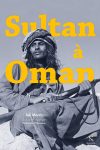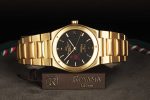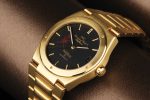IWC Schaffhausen
The Tale of the 1980’s Omani Crested IWC Ingenieur
Beauty From The East
“One fine Arabian morning in the middle of December 1955, I walked into the palace of the Sultan of Muscat and Oman.” It is the sort of opening sentence that inspires confidence in a book. And it is the way in which the celebrated British writer Jan Morris – who was still James Morris at the time – starts Sultan in Oman, a highly amusing, and at times rather lyrical, account of a trip across the country, the narrator being accompanied by its ruler.
The book offers a wonderful snapshot of a fascinating part of the world at a time of great change. At times it reads like a perfectly hilarious picaresque novel, as the Sultan and his caravan of lorries laden with baggage, provisions (some of which started the journey alive), courtiers, servants and slaves career across a country in the making: rebellion is quelled in the north; a border established with the Sheikh of Abu Dhabi in the east; and sundry rugged mountain tribesmen, ambitious oil prospectors and a British soldier of imperial mien are presented for the readers’ amusement.
In many ways, Oman is depicted as a medieval country accelerating through half a millennium of history to join the 20th century. At one point Morris takes a break at an oasis. “I sat down for coffee with a group of friendly and eager tribesmen, and one of them, looking as if he had lived all his life on the back of a camel, suddenly reached across and grabbed my wrist. He wanted to see my watch, he said. Was it a Longines? I understood this well-informed interest, for I knew it was the practice of the Saudis to distribute gift watches according to makes: the more important the recipient, the more distinguished the watchmaker. Thus, since the cases were almost always gold, the best way to size up a man’s significance to the Saudi cause was to discover the maker’s name, and many a poor politician or journalist, returning from a visit to Riyad [sic], had flourished his handsome present from the court without knowing how surely it stamped his status in the Arab world. My Arabs looked a little baffled, for my watch was made by a firm not patronised by the royal house, so that I might have been either desperately important or not worth a second thought.”
The oasis was in the border region of Buraimi, where Morris deduced from the horological awareness of her hosts that Saudi Arabia had been courting local opinion. It is somehow reassuring to know that horological brand literacy and snobbery was one of the first benefits of modern Western ‘civilization’ to make its appearance in this remote corner of the Arabian Peninsula.
Join The Club
It is this little vignette of mid-century Arabia that came to mind some time back when Justin Koullapis and Danny Pizzigoni of The Watch Club said they had something that might be of interest to me: namely a rather unusual IWC Ingenieur.
Koullapis and Pizzigoni are great at what they do, in that they can tell exactly what sort of exotica appeals to me; and knowing my predilection for vintage IWC Ingenieurs, they were pretty sure that the small gold model with the Omani crest – a Kanjahr exotic dagger that curves almost at a right angle superimposed on two crossed scimitars and topped with a crown – could have been made with me in mind. It even came in a fancy presentation case emblazoned with the same coat of arms and lined with white satin and braid in the red white and green colours of the country. Personally, I would like to think that this watch was supplied to the Omanis by British luxury emporium, Asprey.
Usual Custom
At about the same time as Morris was on her travels with the Sultan, a young scion of the 200-year-old Asprey retail dynasty made his first visit to the Gulf. John Asprey was in what was then Persia, with his uncle Algy, on the first of many visits that would see him establish long and lasting friendships with many of the ruling families of the region. Among the objects that he supplied to these families were wristwatches decorated with the national emblems.
“I remember the Saudis were very heavy on Rolex,” Asprey says with an understatement of an earlier generation for whom this was just a part of business rather than the detail-obsessed collectors’ market that it has become. And, in a way, that is what makes these watches so interesting – they speak of a different time and of a watch industry when things were much less corporate than they are today.
Back then it was much simpler, forget marketing meetings, brand identity and so forth. In those days, the watch factories were just interested in selling watches, and if the customer wanted a special dial and was prepared to pay for it, then the customer could have it. “The factories did them,” recalls Asprey. “If I received the order from the Diwan who managed the private affairs of the ruler, we would send the factory the artwork and they did the whole thing.”
Timely Gratitude
I have a particular weakness for the Oman-dialled watches because of the interesting history of the country. When Morris strolled into the sultan’s palace one fine day in 1955, the countries now forming the UAE were known as the Trucial states, which recalls the truce imposed by England upon local warring sheikhs. It may be apocryphal, but I remember reading that it was enacted early in the 19th century because a British ship got caught in the ceasefire, and under the terms of the truce, the states were still allowed to attack each other as long as they had British permission. Things settled into a more general peace by the mid-19th century.
During the 1960s and 1970s, at about the time the British had announced their plans to relinquish control of the Trucial States, an insurrection flared up in Oman. Fighting with modern weapons of Chinese and Russian manufacture, the rebels looked like they might gain the upper hand on the Sultan’s forces, who, as well as being small in number, were making do with equipment of Second World War vintage.
This was the time of the Cold War and memories of the Aden emergency of the 1960s, during which Communist rebels had risen against the British resulting in the eventual evacuation of the British forces, were still fresh. In 1970, a coup saw the Sultan replaced by his Sandhurst-educated son, followed by the arrival of SAS soldiers to fight the insurgents, and one of the ways in which the new Sultan recognised the valour of these soldiers was with special watches.
Voluntary Excess
Dating from the 1980s, the IWC brought to my attention by The Watch Club is too recent to date from that conflict, but it is an interesting period piece nonetheless and it also shows that IWC can make very pleasant small watches (the diameter is 34mm) when it puts its mind to it. It also resonates with me because it comes from an interesting time in IWC’s history when the marque enjoyed a very strong technical reputation and was less focused on the large masculine pieces that characterise the brand today.
The late-1970s and 1980s witnessed the birth of watches now almost forgotten like the Yacht Club II, a sort of Royal Oak-alike that is much rarer than the Oak and other really wonderful dress watches featuring hard stone dials and textured gold bracelets. They were watches of a design and funkiness that is decidedly at odds with the austere Germanic style of Schaffhausen and puts one in mind of the more outrageous creations of Piaget at the zenith of the Yves Piaget era. And after a bit of rooting around in the archives at IWC, it seems that the Diwan of the Sultan during these decades shared my taste for disco-era extravagance.
However, while they might suit my magpie eye, they did not always suit their recipients as Hannes Pantli, a former IWC Sales Director, recalls. Flying back from Oman, Pantli remembers meeting a former SAS officer who worked as a military adviser. “The former SAS officer showed Mr. Pantli an IWC watch with fancy diamonds, cufflinks and the lighter he got from the Sultan as a gift,” says Seyffer. “Not knowing that Mr. Pantli worked for IWC, he said he could not wear such a watch in England.”
If by any chance that former SAS officer is reading this article, please get in touch with me via the offices of Revolution UK as I sense that maybe there is a deal to be done.














